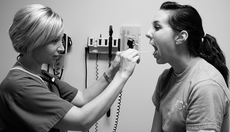The staff in University Health Services is doing everything it can to make sure Nicholls students do less sneezing and wheezing and stay healthy this influenza season. With the rise of the new H1N1 virus, known commonly as “swine flu,” it is important to prevent the conception and the spread of the seasonal influenza virus, as well as the H1N1 virus.
According to the Centers for Disease Control and Prevention (CDC), H1N1 was first detected in people in the United States in April, and it is spreading much like the seasonal flu. In June, the World Health Organization declared that a pandemic of H1N1 was underway.
When H1N1 made its first appearance in the media, it was referred to as “swine flu” because it had many of the same genes similar to a flu virus that infects pigs in North America. However, further studies showed H1N1 is different from the seasonal flu because it has two genes from viruses that flow in pigs from Europe and Asia, bird genes and human genes. Scientists call this a “quadruple reassortant” virus.
The CDC has determined that H1N1 is contagious and is thought to occur the same way seasonal flu spreads. Flu viruses spread mainly from person-to-person through coughing and sneezing. Just touching something covered with the virus and then touching your mouth or nose can also infect a person.
Symptoms of H1N1 are the same as seasonal flu symptoms. Signs include fever (often high), headache, extreme fatigue, dry cough, sore throat, runny or stuffy nose, muscle aches, vomiting, diarrhea and nausea. These symptoms are not severe but should be taken care of by a physician immediately. Emergency signs of someone needing urgent medical attention are difficulty breathing or a shortness of breath, pain or pressure in the chest or abdomen, sudden dizziness, confusion, severe or persistent vomiting or diarrhea and flu-like symptoms returning with a fever and a worse cough.
Many techniques are helpful in preventing the conception and the spread of the seasonal flu and H1N1 viruses. First, University Health Services stresses the importance of hand-washing, saying “the best way to avoid getting the flu is to wash your hands regularly throughout the day.” It is recommended to use hot, soapy water and wash for 20 seconds, or the length of time it takes to sing the “Happy Birthday” song, at each washing. Alcohol-based hand sanitizers are also an effective alternative.
Second, cover the nose and mouth with a tissue when coughing and sneezing. Throw the tissue in the trash after use. The germs will go into the garbage instead of staying on your hands or floating into the air others breathe.
Third, avoid touching the eyes, nose or mouth. This should be practiced even when not sick. The eyes, nose and mouth are passageways for germs to spread.
Lastly, and most importantly, stay home if sick. The CDC recommends staying home for at least 24 hours after fever has subsided except to receive medical care or for other necessities. Other procedures that can be taken are: following public health advice with regards to school closures and social distancing and being prepared in case sickness sets in. Keeping a supply of over-the-counter drugs, hand sanitizer and tissues is useful. University Health Services also suggests finding healthy ways to deal with the stress and anxiety of the virus, saying “exercise, adequate sleep and a healthy diet are all good ways to avoid getting the flu.”
There are medicines for the treatment and/or prevention of infection with H1N1. The CDC mentions the use of oseltamivir or zanamivir, antiviral drugs prescribed to fight against the flu viruses reproducing in the body. Antiviral drugs come in the form of pills, liquid or inhaled powder. If sickness sets in, antiviral drugs make the illness milder and prevent serious flu complications. However, the priority use of the antiviral drug is for severe influenza cases or people who are at risk of having serious flu-related complications.
Diane Garvey, director of University Health Services, says there will be no testing for the flu on campus because of the amount of money it would cost students. Nevertheless, she says the prevention measures are working “because we have not seen a lot of influenza-like symptoms. Everyone is doing what they are supposed to be doing, and I want to applaud the students, faculty and staff for following the suggested measures.








